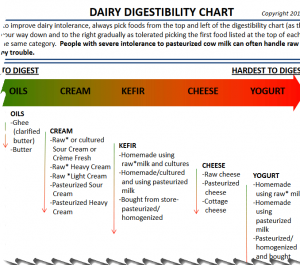
Click the image to download my DAIRY DIGESTIBILITY CHART. Not sure which one is “safest”? Start with the ones which are easiest to digest.
There’s a big difference between lactose intolerance and casein sensitivity. And depending on which one your child has, there are types of dairy products which are better than others for sensitive stomachs and symptoms.
If your infant or child is lactose intolerant or has a hard time with dairy such as cow milk (eczema, constipation, reflux, gas, skin rashes, ear infections, etc), here is a chart to help you understand which dairy foods are easiest to digest vs. most difficult so you can see the whole spectrum of digestibility of different types of milk, different varieties of cultured dairy products, cheese, and yogurts.
Some children are lactose intolerant and experience gas and tummy aches. But more often, kids suffer from CASEIN intolerance which can cause constipation, reoccurring ear infections, sinus infections, coughs, foggy thinking/learning challenges, eczema, skin rashes, tics, behavioral problems, and “addictive” cravings for dairy.
Based on the chart, if your child is intolerant to casein, he or she may be able to consume ghee (clarified butter) without any issues since it contains little to no casein. However, you’ll want to eliminate all other types of dairy to see how it impacts symptoms.
Lactose intolerance is another issue altogether. If you child gets tummy aches and cannot consume pasteurized cow milk, it does NOT mean that he/she cannot have other types of dairy. You may be surprised to discover that raw dairy (unpasteurized and non-homogenized) milk (especially A2A2 breed) is able to be easily digested by about 70% of lactose intolerant children. It’s worth a try! See the chart for type of milk and dairy options.
In addition, high fat cultured dairy is more easily digested than low-fat and non-fat. Check out the chart by clicking the image or link here: Dairy Digestability v3 PDF chart.



